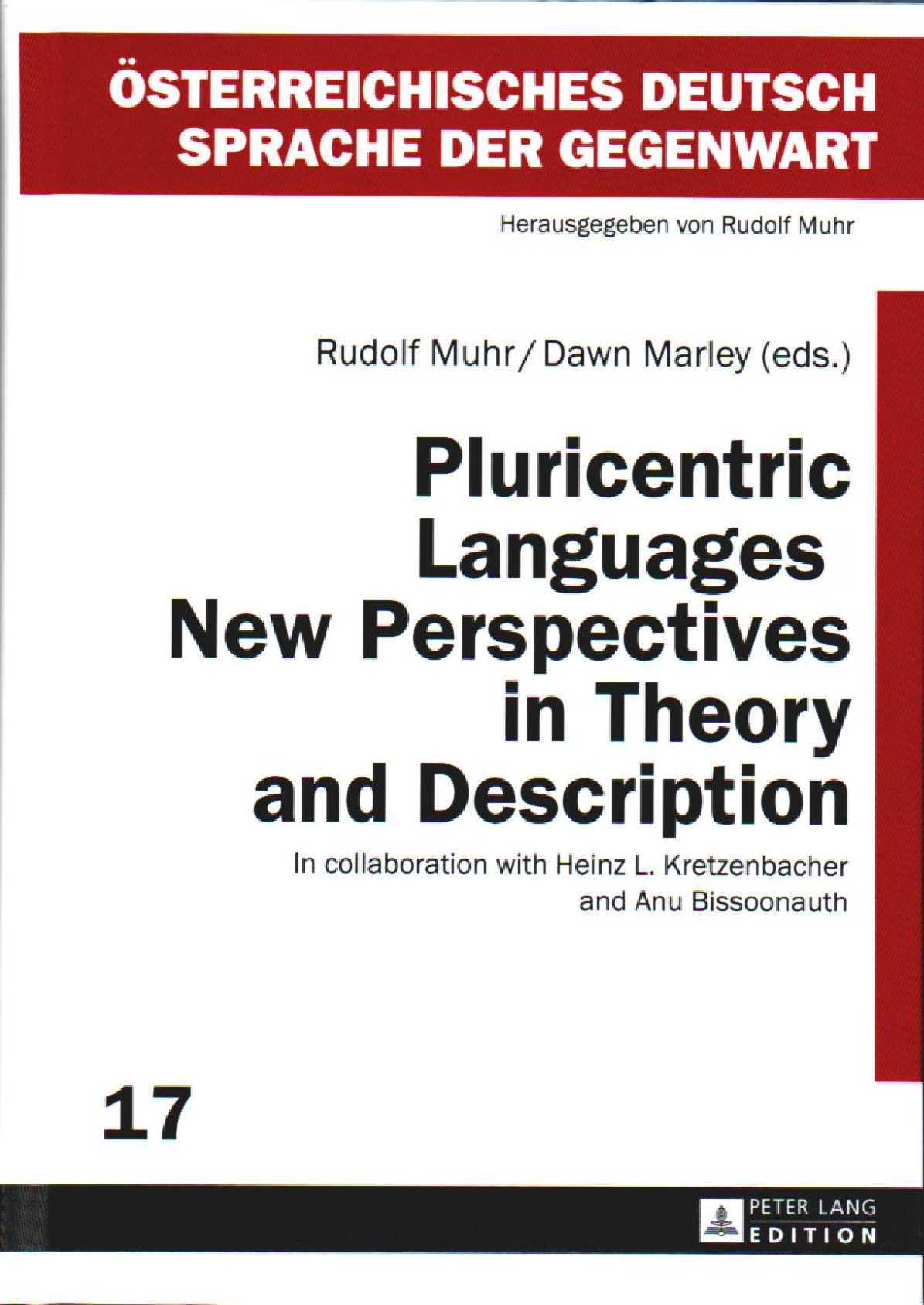Pluricentric Languages: New Perspectives in Theory and Description.
edited by Rudolf Muhr, Dawn Marely, Anu Bissoonauth-Bedford, Heinz L. Kretzenbacher

The volume comprises papers about theoretical aspects of pluricentricity and methods of description of variation in pluricentric languages; Pioneering papers about “new” pluricentric languages and “new” non-dominant varieties that have not been described before; Pluricentric languages that are used alongside indigenous languages; The pluricentricity of special languages.
Keywords: Pluricentric theory
Language(s) dealt with: English
Details
published by Peter Lang Verlag (Vienna/Frankfurt a. M. et.al.)
October 30, 2015 | 318 p. pages | ISBN 978-3-631-66433-9 (Print) — ISBN 978-3-653-05594-8 (E-Book)
Preface
This volume comprises a selection of 17 papers that were presented at the “3rd International Conference on Non-Dominant Varieties of Pluricentric Languages” which was organized by the “Working Group on Non-Dominant Varieties of Pluricentric Languages” and was held at the University of Surrey, Guildford (UK) on the 3rd and 4th of July 2014. The main aim of the conference was to strengthen the theory and extend the description of pluricentric languages around the world.
During the past conferences it became clearer that the standard theory of pluricentricity would not apply to complex multilingual language situations such as those found in former colonies where nativised varieties have developed alongside diglossic or multiglossic language use. It also became apparent that other theoretical problems had to be considered when pluricentric languages in the making are included, such as second level types of pluricentricity and formerly unrecognised pluricentric languages, whose status is unclear. The first two conferences have also shown that the scope of what constitutes pluricentricity is far wider than what was originally envisaged. When Michael Clyne coined the term “pluricentric languages” in 1984, it made sense to restrict it to national standard languages of the “larger” pluricentric languages. However, it is now clear that many other languages should be included, such as Catalan in Europe and Bengali in Asia.
A further objective of the conference was to work on a more viable definition of what pluricentricity actually means in the context of research on non-dominant language varieties. The papers in this volume fall into four main categories:
Section (1) comprises papers about theoretical aspects of pluricentricity and methods of description of variation in pluricentric languages: It is introduced by Rudolf Muhr’s paper, which presents key factors that are likely to establish and support linguistic dominance in pluricentric languages. Gerhard Leitner shows that the inclusion of the specific language situation (habitat) is necessary for the description of complex language situations like those that exist in post-colonial contexts. Danica Salazar presents the first paper that gives a thorough account of the way vocabulary from NDVs of English is included in the OED. Carla Amorós Negre deals with the practical and theoretical problems of multi-national standardisation of Spanish. Amália Mendes and her colleagues from Portugal and Brazil explore an extensive amount of data from virtually all national varieties of Portuguese around the world. The specific usage of two key features of Portuguese (pronominal constructions and subject indetermination) gives clear indications of the different national varieties. The section is closed with a paper by Sofie Henricson and her colleagues from Sweden and Finland who research the specific pragmatic and interactional differences in supervision meetings that exist between Sweden Swedish and Finland Swedish.
Section (2) contains a number of pioneering papers about “new” pluricentric languages and “new” non-dominant varieties that have not been described or dealt with in any detail before. Aditi Gosh’s paper is the first one about Bengali as a genuine pluricentric language. Bengali is not only a very “large” language by the number of speakers, it is also a pluricentric language, since it has the status of a national language in both Bangladesh and India. Gerhard Edelmann shows on the example of Catalan how complex and intricate the situation of a pluricentric language can be due to political and geographical fragmentation. Salvatore Del Gaudio and Olga Ivanova have investigated the even more complex situation of Ukraine Russian. It is marked by strong language contact with the linguistically very close Ukrainian language. However, the authors found indications that there is a specific Ukraine variety of Russian. In the light of the latest political developments, its future development is totally unclear. Quite in the same vein are the papers by Susanna Afonso and Francesco Goglia about Portuguese in East Timor and by J. Thomas about US Spanish. The authors present findings that indicate linguistic developments in both cases that might lead to the development of distinct national varieties of both languages in the respective countries. Similar processes are going on in Peninsular Spanish, as Nativad Hernández Munoz shows, if on a national rather than on a transnational level. The speakers of La Mancha seem to develop strong awareness for a regional variety that in the near future might play a role on the level of “second level” pluricentricity (within a national variety). Karoline Kühl’s contribution also points in this direction. Her findings about South Schleswig Danish – a regional spoken variety of Danish in Germany – show that there is bilingual language usage, but also a high amount of stigmatisation due to the uncodified status of this variety. Finally Máté Huber and Timea Molnar present data about attitudes towards the NDVs of Hungarian in the neighbouring countries, indicating a strong awareness for these varieties in the Hungarian language community.
Section (3) showcases pluricentric languages that are used alongside indigenous languages. Both papers in this section are concerned with the usage of English and French in two rather different multilingual countries which have a colonial past in common. Anu Bissoonauth researches the usage of these languages in New Caledonia – a cluster of islands in the Pacific Ocean, where about 40 native languages are used. Kelen Fonyuy presents research on how the pronunciation of English and the usage of English and French in Cameroon are used to convey different social attitudes.
The fourth and last section deals with the pluricentricity of special languages. Tanja Wissik shows that the terminology of the academic educational system in Austria, Germany and Switzerland is marked by substantial differences that deserve intensive research.
Together with the authors, we hope that this collection will be well received and will help to intensify the discussion about theoretical, methodological and practical issues related to the description of pluricentric languages. This hope is shared by the organisers of the conference at the University of Surrey and the members of the “Working Group on Non-Dominant Varieties of Pluricentric Languages” (www.pluricentriclanguages.org).
We would like to thank the regional government of the Austrian Bundesland Styria for the financial support of this publication and those who – in addition to the editors – acted as reviewers and helped in the editing of the manuscript: Catrin Norrby (Stockholm, SE), Johan de Caluwe (Ghent, BE), Augusto Da Silva (Braga, PT), Nils Langer (Bristol, UK), George Lüdi (Basel, CH), Günther Leikauf (Graz, AT), Josep-Àngel MAS (València, ES); Flemming T. Stubkjär (Odense, DK) and Klaus Zimmermann (Bremen, DE).
Rudolf Muhr, Dawn Marley Heinz L. Kretzenbacher and Anu Bissoonauth
Graz,Guildford, Melbourne, Wollongong – March 2015
